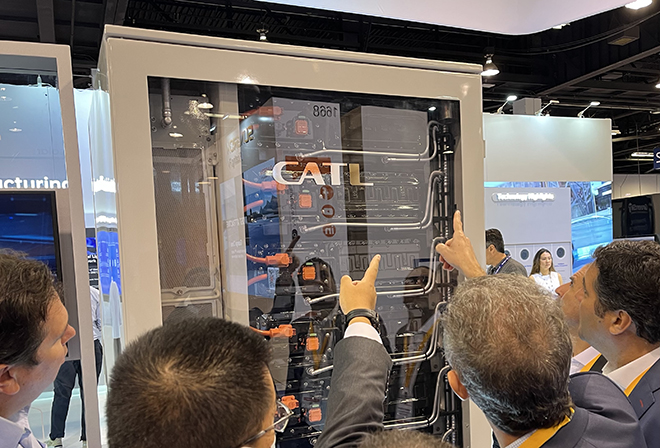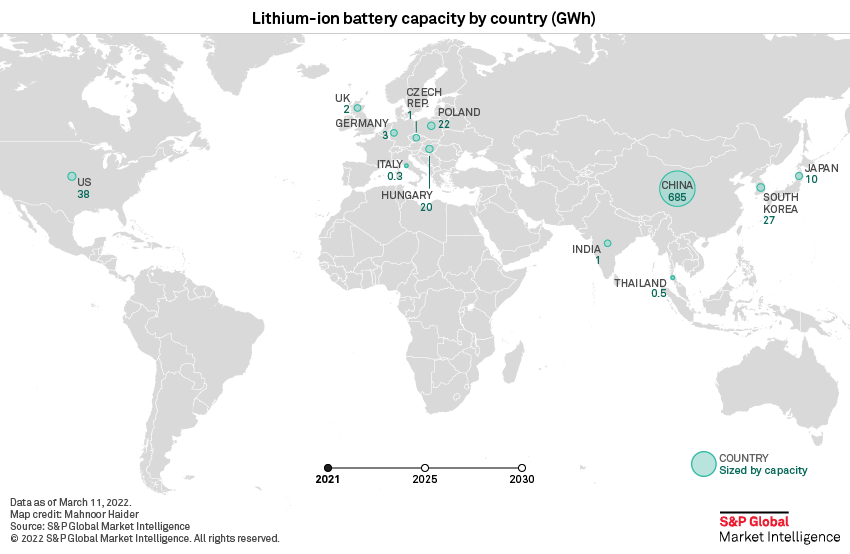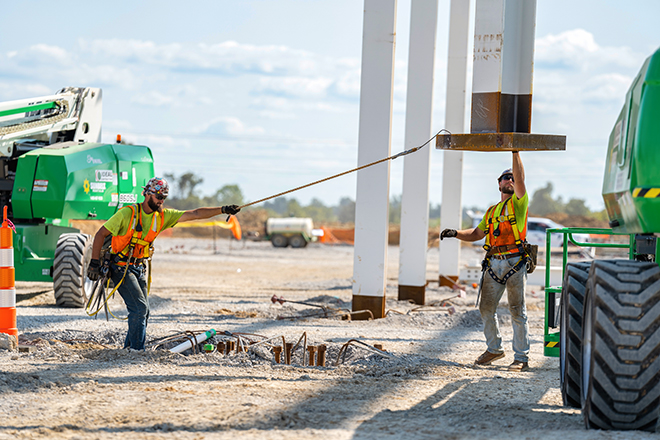S&P Global Offerings
Featured Topics
Featured Products
Events
S&P Global Offerings
Featured Topics
Featured Products
Events
S&P Global Offerings
Featured Topics
Featured Products
Events
Banking & Capital Markets
Economy & Finance
Energy Transition & Sustainability
Technology & Innovation
Podcasts & Newsletters
Banking & Capital Markets
Economy & Finance
Energy Transition & Sustainability
Technology & Innovation
Podcasts & Newsletters
S&P Global Offerings
Featured Topics
Featured Products
Events
3 Oct, 2022

| Ningde, China-based Contemporary Amperex Technology Co. showed off its batteries at a recent Source: S&P Global Market Intelligence |
Contemporary Amperex Technology Co. Ltd., the world's largest supplier of lithium-ion batteries, based in Ningde, China, is in discussions with its U.S. customers, including major automakers and energy storage developers, about establishing its first manufacturing hub in North America.
The company, known as CATL, is "in talks" with its customers on "various possibilities for supply and cooperation, including local production in North America," according to a company spokesperson. In developing its overseas investment strategy, the battery maker is considering such factors as "market demand, investment environment, development of local industry chain, availability of skilled labor and level of cost," the spokesperson said in an email.
CATL's considerations come amid a flood of new investment into U.S. battery manufacturing as mass markets begin to emerge for electric vehicles and stationary energy storage systems. New and expanded federal tax incentives in the recently passed Inflation Reduction Act are widely anticipated to drive battery demand and domestic production to significantly higher levels this decade.
Over the past year, makers of electric vehicles, as well as developers and integrators of large- and small-scale battery storage systems, have battled rising prices, shortages and delays. As a result, they are all seeking to regionalize their supply chains. But, so far, battery cell joint ventures between automakers and international suppliers are behind most of the new investments, leaving uncertainty over how much domestic output will remain for stationary storage.
"That's my biggest concern," said Jeff Damron, senior director of global energy storage business development and marketing at Wärtsilä Oyj Abp, a customer of CATL and other battery suppliers.
If EV demand soars higher and faster than anticipated, "I could see that the stationary storage world gets squeezed to a degree," Damron said in an interview. "But, at the same time, the amount of capacity that's been announced over the next five to 10 years is astounding, so I am optimistic that we can manage through this situation."
"There's a long-term incentive to creating capacity in the United States," added John Zahurancik, president of the Americas region at Fluence Energy Inc., an energy storage technology and services specialist launched by Siemens AG and AES Corp. in 2018.
Fluence acquires imported cells, on which the U.S. market remains heavily reliant, for assembly into full systems at a new contract manufacturing facility in Utah.
"We're in a tight space right now, but every manufacturer [of cells] has plans for expansion," Zahurancik said. "So I think the question is, just how do we navigate the next couple of years when things look like they're going to be tight?"

EVs drive US battery build-out
Already a big battery production build-out is gathering momentum in North America.
In September, Ford Motor Co. broke ground on a multibillion-dollar advanced manufacturing complex for electric trucks and lithium-ion batteries in western Tennessee. It is part of a planned $11.4 billion investment with SK on Co. Ltd., an affiliate of Seoul-based SK Innovation Co. Ltd., on factories in Tennessee and Kentucky.
General Motors Co. and LG Energy Solution Ltd., another South Korean battery maker, in July secured a $2.5 billion loan from the U.S. Energy Department for their Ultium Cells LLC venture. The companies have announced plans to invest at least $7.2 billion into lithium-ion battery cell plants in Michigan, Ohio and Tennessee.
LG Chem Ltd., the parent company of LG Energy Solution, is exploring upstream battery cathode production in North America with GM as well. LG Energy Solution is also involved in a joint venture with automaker Stellantis NV that will invest more than C$5 billion into a lithium-ion battery production factory in Ontario, Canada.
Stellantis, meanwhile, is working with Samsung SDI Co. Ltd. on an up-to-$3.1 billion cell and module production site in Indiana. And an affiliate of Panasonic Holdings Corp. in July announced a plan for a roughly $4 billion battery manufacturing facility in Kansas, building on its production hub with Tesla Inc. in Nevada.
Such plans could drive a tenfold jump in U.S. lithium-ion cell manufacturing capacity between 2021 and 2025, to 382 GWh, according to a forecast from S&P Global Commodity Insights. That would increase the U.S. share of global lithium-ion battery cell production capacity to nearly 14% by 2025, up from 4.7% in 2021.
Should a weaker overall economy hit demand for electric vehicles, energy storage stands to benefit, according to Zahurancik. "The grid stuff is tending to not really move so much in sync with the economy; it's moving more in sync with need for modernization of the grid," Zahurancik said.
While storage system integrators and developers have seen battery prices recently level off following a significant spike over the past year, uncertainty remains over when prices might resume their long-term decline.
"It's too early to declare victory there because we're the tail on the EV dog," said Tom Buttgenbach, CEO of solar and energy storage developer Avantus LLC, formerly known as 8minute Solar Energy.

|
Ford broke ground on a major new electric vehicle and battery complex in Tennessee in September as part of a joint venture with South Korea's SK On. |
Seeking dedicated energy storage supplies
Jamal Burki, president of IHI Terrasun Solutions Inc., an energy storage systems affiliate of IHI Corp., believes the U.S. energy storage industry ultimately needs more second-tier battery manufacturers that are not as tied to EVs.
"That's going to be very, very important," Burki said in an interview. "Otherwise, I think our industry is going to suffer because of lack of battery supply."
He expects the Inflation Reduction Act to encourage new dedicated capacity for energy storage. The law includes manufacturing tax credits for battery modules, cells and materials; a new stand-alone storage tax incentive for project owners; and bonus incentives for using certain levels of domestic content.
The energy storage industry awaits clarification in coming months from the federal government on what exactly can qualify as domestic content for the purpose of securing a 10% bonus on tax credits, for instance, whether domestic cells will be required. In the meantime, it may still take years to fill in the currently large gaps in the domestic energy storage supply chain.
"I don't see that happening right away," Burki said. "It's a 10-year horizon because you've got the materials challenge, you've got the labor challenge, you have the know-how challenge."
KORE Power Inc. is one aspiring player seeking to scale up with the new federal tax credits.
The U.S. lithium-ion upstart currently has its cells made in China by a contract manufacturer. These cells are imported to an energy storage assembly factory in Vermont. In moving to a more domestic model, KORE Power intends to secure debt and equity financing by the end of 2022 to enable the construction of a nearly $1 billion lithium-ion cell plant in Buckeye, Ariz., according to founder and CEO Lindsay Gorrill.
The facility is scheduled to start production in late 2024 with an initial 12 GWh of capacity.
"There's a lot of need for energy storage, and we're really good at energy storage," Gorrill said. With the incentives in the Inflation Reduction Act, "the U.S. cost of cells and modules will be the same as or less than China," he added.
Salient Energy is among a growing number of startups seeking to commercialize lithium-ion battery alternatives for energy storage. The Canadian company, which has a pilot-scale factory for zinc-ion cells near Halifax, Nova Scotia, plans to build its first full-scale manufacturing plant in the U.S.
"By middecade, we want to be shipping substantial volumes," CEO Ryan Brown said.
Energy storage system developers and integrators hope to see such new supplies come to fruition.
"Everybody's trying to figure out what are the real timelines around getting to U.S.-based manufacturing ... and who's real, who's not," said Wärtsilä's Damron. "I think we have a good idea of the direction, but the other piece of it is, this is not going to happen overnight. It's a multiyear transition."
S&P Global Commodity Insights produces content for distribution on S&P Capital IQ Pro

